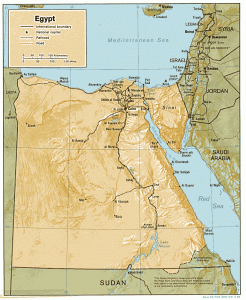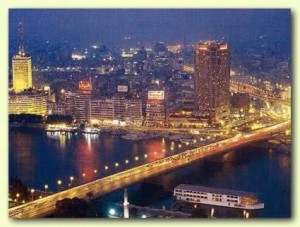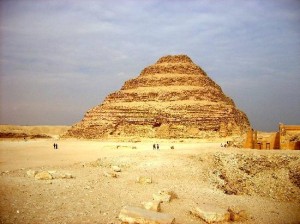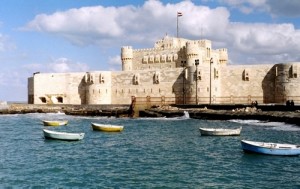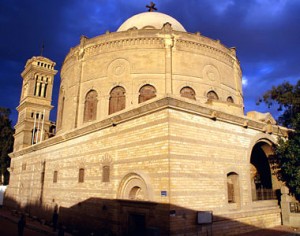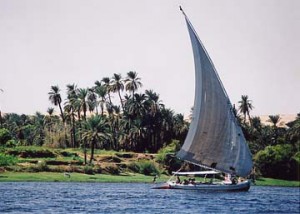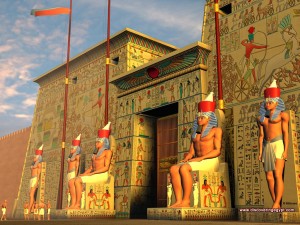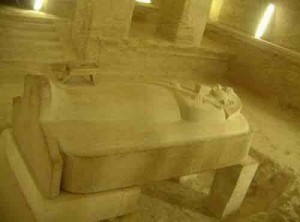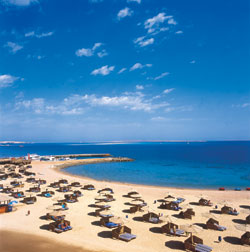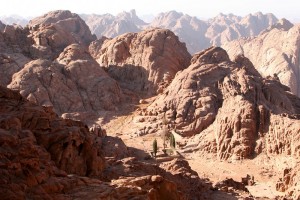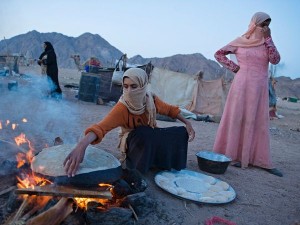This article is written by Manoj Radhakrishnan, an engineer and a travel photographer & writer based in Pune
There are not many countries in the world which present greater tourist attractions than Egypt and certainly not many with a longer history. Attractions in Egypt are so well known that the response to “I am off to Egypt” is always a “When?” and never a “Why?”. Not surprisingly, for the first time in three attempts, it wasn’t hard for me to convince a couple of my friends – Aravind and Kartik – to join me for a trip overseas. And my long cherished dream of visiting Egypt finally came true when I landed in Cairo late one sultry summer evening.
Travelling in Egypt, like travelling in any new region, had its share of idiosyncrasies. Adjusting to strange numerals in the automobile license plates to ceiling fans which ran faster at lower regulator settings was challenging enough, but the hardest thing to cope with was the security. It ranged from being forced to register your passport within the first week to walking through x-ray machines every time one entered a hotel, bank or a shop selling chewing gums. But the high point was definitely the intercity convoy – which is a bunch of tourist vehicles flanked by army trucks with each tourist vehicle having a pair of Kalashnikova carrying policemen. As if this wasn’t enough, the convoy always chooses to leave at the strangest early morning hours. The funniest part is that the convoy invariably falls apart within metres of leaving the city and the policemen always try to outdo each other in emulating Rip Van Winkle. Luckily, the convoy does not exist off the beaten track, that is if you can put Sinai and Alexandria in that category. Despite these minor glitches, the overall security in the country is enough to protect you from everything except perhaps the obstinate shop keepers who refuse to believe that one may not be interested in buying spices at three in the morning.
Given the security, it was no surprise to learn that Egypt is extremely safe to travel around. But it was definitely surprising to hear that the tourism wasn’t affected by the events of 11th Sep. The only thing that seems to keep the tourists away is the heat. Summer in Egypt is a constant 40 C + which, thanks to the hot winds, seems twice that in the Sahara. Even our group strength was only nine (four during the last week) – it is normally about twice as big. Some of us were badly affected by the heat and almost all of us were dehydrated at least once during our stay. On the bright side, enduring that heat offered us a chance to photograph the country’s monuments without having 200 clueless tourist staring randomly in the foreground. Luckily for me, I came back without doing much damage to my body. Although I am tempted to attribute it to my strong build and rugged lifestyle, the real reason for my good health is just dumb luck.
Egypt has enough history to leave anyone dazed. It is easy to feel intimidated by so many names and information hurled at you everyday. Although doing a bit of research before the trip helps, we quickly realised that our best defence was to hire a guide at every spot, be it a temple, tomb or a museum. Even in the following pages, I have tried my best to separate the historical information about the sites – all of which are accessible via hyperrlinks – from the general travel journal.
It is not possible for me to end this section without mentioning a strange torture me and my two friends were subjected to during our trip, we being singled out purely due to our country of birth. Everyone we met, passed by, ignored, saw, didn’t notice, was adamant in addressing us as Amitabh Bacchan, an Indian film star of the ’80s. How they could figure out our nationality is still beyond my comprehension and by the end of the trip, I was pretty much reduced to referring to my passport to remember my own name!
A night view of Cairo
We spent three days in Al Kahira (otherwise known as Cairo) which was just about enough to give us a taste of what the city has to offer. The first of those three days was spent at the two of the biggest attractions of the city viz., the Giza pyramids and the Egyptian museum. Over the centuries the pyramids seem to have become the symbol of not only the country, but of history itself. The impact of the first sight of them was pretty breathtaking to say the least. The pyramid of Kufu (Cheops), the tallest of the three Giza pyramids, is the only surviving member of the seven ancient wonders of the world and at a height of 140m, it also remained as the tallest structure in the world for over forty centuries.
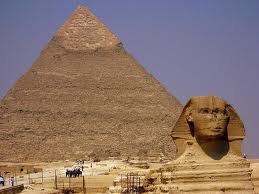 The sphinx and the pyramid of Khafre (Chephren)
The sphinx and the pyramid of Khafre (Chephren)
Our time at the site was spent going into the pyramid of Khafre (Chephren) – which involved crawling through a long dark narrow passage half the human height – looking at the 4500 year old solar boat of Kufu (currently preserved in a temperature and dust controlled museum) and driving to the nearest plateau point to get the view of all the three pyramids in one shot. And of course, no trip to the region is complete without gaping at the sphinx and visiting the valley temple of Chephren and the nearby Papyrus institute – all of which were duly completed before lunch. The Egyptian museum is so huge that it would take about an year to view all the exhibits. But a good guide can show you the highlights and probably teach you quite a bit of Egyptian history in less than two hours. We had a great guide, Sahar, and I probably learnt more from her in that afternoon than my month long self study prior to the trip. The highlight of the museum was definitely the Tutankhamun’s section and the mummy room. The gold collection of Tutankhamun makes one wonder how much a pharaoh like Ramesis the great could have carried to his grave when the least important boy king took west Africa’s budget deficit with him. The mummy room, on the other hand, presents you with an unique opportunity to look at Egypt’s greatest rulers centuries after they breathed their last.
We had our next free day in Cairo after we returned from Sinai to complete the first leg of our three week tour. That day the three of us along with Melody, Jane and David took a trip to Saqqara and Memphis and braved the scorching heat to visit the oldest stone structure in the world – the step pyramid of Djozer. Built in 27 century BC by Imhoptep, the step pyramid is still in a very good condition. Saqqara complex also houses many other tombs, most of which are always closed for renovation or excavation. The ones which were open included the funerary complex of Djozer, the pyramid of Teti with its famous pyramid text, and the 32 room funerary complex of his vizier, Mereruka. Memphis, the capital of the first dynasty (c. 3200 BC), contrastingly, has nothing to offer except a small museum housing a fallen statue of Ramesis II. This day was also the day when we bid farewell to half our group and the rest (the three of us and Melody) continued on to Siwa and Alexandria.
The final day we spent in Cairo was also the last day of our trip. By this time our group was reduced to just three, thanks to the tummy bug which Melody managed to catch in the desert. The day started off with an hours drive to Dashur to visit Snefru’s red and bent pyramids, the forerunners of the Giza pyramids. We all got a feel of how huge these structures are when we all walked up 100 odd steep steps to get to the entrance and walked 150 more down a 45 degree narrow incline to reach the inside of the red pyramid. The pyramid looked twice as impressive from inside as outside. There are as many theories about the pyramids as there are self-proclaimed egyptologist. Not wanting to be left behind I have my own : going by the size of the openings found in these structures, I propose that the pyramids must surely have been built by pygmies!
We spent the rest of the day visiting the Coptic Cairo and the Citadel. The Coptic museum, which contains relics dating from the first millennium AD and the hanging church, a 7th century church built on top of two towers (and hence the name) were the only things from the Coptic region which fit into our itinerary. The Citadel is the site of the famous Mohammed Ali mosque, built in 1830s as a scaled down replica of the blue mosque in Istanbul. It also houses the Mohammed Ali’s palace where the host murdered 40 mameluke chiefs to start a new dynasty.
In the night, we had to choose between the sound and light show at the pyramids and a belly dance display. Like any self-respecting gentleman would have done, we chose the latter. We were very close to kicking ourselves when the best belly dancer turned out to be Aravind, when he was pulled in for a few seconds to add some interest to the proceedings. The whole event would have become a fiasco but for a male dancer who with his amazing spinning skills kept everyone captivated for better part of an hour. Thanks to one of the visitors of the page, Dianne Horvath, I later learnt that this “spinning guy” does have a title: “Whirling Devrish”!!
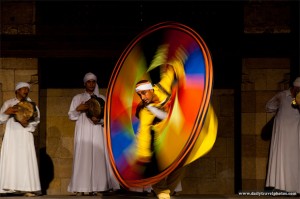 Dance of The Whirling Dervisch, Egypt
Dance of The Whirling Dervisch, Egypt
As mentioned earlier, the last day in Cairo also marked the end of our three week trip to this wonderful country. As with any other trip, this one too ended with me being forced to spend the rest of the year in a 10 ft X 10 ft cubicle….
At the end of the first day in Cairo, we took an overnight train to Aswan. An overnight seater in a vehicle which goes into a vibrating trance every few minutes was not what the body was crying for having spent the previous night in an equally annoying aeroplane seat. But at least it brought us to Aswan with enough time to spare on the following day for sightseeing.
The two days in Aswan – outside one crazy afternoon on the Sahara dunes – were easily the hottest days on our trip. Almost all of us were dehydrated by the end of our stay. On the first scorching day, we covered the unfinished obelisk, – abandoned due to a flaw in the stone, although I sincerely think that the entire crew would have vapourised in the heat – the Aswan high dam, the Nubian museum, and the island temple of Philae. The Philae temple was easily the pick of the lot, its island setting adding to its beauty. This temple along with the pair in Abu Simbel were moved piece-by-piece to a fresh site when the Nile flooded the original location after the building of the Aswan high dam. The temple, however, looked twice as pretty under the lighting for sound and light show in the night.
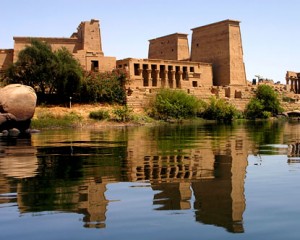 The Temple of Isis, Philae, Egypt
The Temple of Isis, Philae, Egypt
We had to get up at an inhumanely hour early next morning in order to catch the convoy to Abu Simbel. As a consolation for the early start we got to see a spectacular sunrise over a pretty dramatic desert scenery. The twin temples at Abu Simbel, dedicated to Ramesis the great and his wife, Nefertari, were easily the best among the monuments we saw during our trip. The four 20m tall statues of Ramesis, staring coldly at Nubia across the Nile, were awe inspiring to say the least. Equally amazing is the feat how the temples and the mountain were rebuilt here after the Nile flooded in the ’60s.
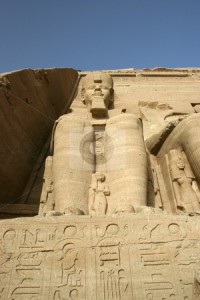 The statue of Ramses II at The Abu Simbel Temple
The statue of Ramses II at The Abu Simbel Temple
The three of us and Melody were the only souls brave enough to spend one more afternoon in the Aswan heat, this time to visit some of its lesser known attractions. We started off with the tombs of the nobles, which was worth the effort for the bird birds eye view we got of the city. A distinctly uncomfortable 30 minute camel ride from there brought us to the San Simeon monastery, a 7th century monastery destroyed by Salah al-Din during the crusades. Aswan also has two islands : a smaller “Kitchner island” which due to the work of a British General, Kitchner, is entirely dedicated to some exotic plants and a larger “Elephantine island” which contains a ruined temple. We walked through the former and floated past the latter to bring our afternoon adventure to a close.
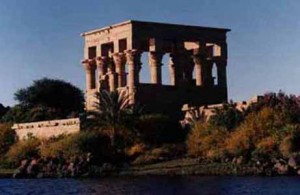 Temple of Elephantine Island at Aswan, Egypt
Temple of Elephantine Island at Aswan, Egypt
We spent the next three days and three night floating down the Nile – from Aswan to Edfu – on a felucca, a lanteen-sailed boat introduced by the Romans. After five days of sleep depravation, three days on a felucca was exactly what the doctor ordered for us. The antics of Mohammed, the captain of the boat, ensured that we were never bored and his cooking skills ensured that we were never hungry during our trip. It was a pity that the heat had taken its toll on Bec and she couldn’t join us on the boat trip.
The temples of Kom Ombo and Edfu were the big stops worth mentioning on our trip. The temple of Kom Ombo sits right on the banks on the Nile and is perfectly symmetrical about its centre and hence contains two temples in one. The one on the left is dedicated to Horus the elder (the brother of Osiris) and the one on the right is dedicated to the crocodile God, Sobek. The temple of Edfu is dedicated to Horus the younger (the son of Osiris) and is one of the best preserved temples in the country. The temple is the site of the famous battle between Horus and his evil uncle Seth, the slayer of Osiris. The reliefs of the temple show many hippos being killed during the annual ceremonies to symbolise the defeat of Seth, who used to take the form of a hippo.
Edfu actually is the farthest from Aswan a tourist is allowed to wander on a felucca after which one is forced to take a mechanised means of transport. By covering 100 odd kms over 3 days, the feluccas are not the fastest way to travel in the Egypt, but it definitely is the best way to enjoy the changing moods and scenery of the Nile.
A two hour bus ride from Edfu brought us to Luxor, the capital of the Middle and New kingdoms and one of the most visited cities in Egypt. Luxor has enough things to offer to occupy a week long itinerary, and the two half days we had allocated for the city was woefully inadequate. It was just about enough to cover the absolute must sees and get an overall picture of the place.
Luxor temple, built by Amenophis III and Ramesis II, was our first stop, thanks to the strange museum timings which keeps them closed during the hottest times of the day. The temple was the home of Amun’s consort Mut and his son Khonsu while Amun, the greatest God of the region resided in the nearby Karnak. The famous Opet festival started at Karnak and ended at the Luxor temple. The courtyards of Amenophis III and Ramesis II were the most impressive part of the temple. Compared to the Luxor temple, Karnak is a monumental megalith built over 1300 years starting with Sesostris I’s XII dynasty core. Without the service of a guide it is easy to get lost in the 100 acres of Karnak ruins – large enough to house 10 great cathedrals. Highlight of the temple are the unbelievable 6000 sqm hypostyle hall housing 134 columns 15 to 23m high, the ram headed avenue of the sphinxes, queen Hatshepsut’s well preserved obelisk, her wall showing the scars of the earliest political vandalism when her step son, Tuthmosis III, destroyed all her images. Although the sound and light show gave us the opportunity to come back and see the complex by night, we all felt that it was too boring to sit through.
Apart from visiting the temple we also had enough time on the first afternoon to squeeze in two of the best museums in the city – the Luxor museum and the mummification museum. Luxor museum houses one of the best sculptures of the country and more importantly is small enough not to intimidate the visitor by its sheer volume. The beautiful statues of Amenophis III and the recreated walls from the Amarna period stand out among the exhibits. The mummification museum is even smaller; but is big enough to give one an overall picture of the ancientmummification process.
The next morning we took a 3 hour donkey ride – which proved how wrong I was to critticise the camel ride in Aswan – to the valley of the kings. Fearing that the conspicuous pyramids are an open invitation for the tomb robbers, the pharaohs starting from Tuthmosis I had their tombs cut inside the arid Thebean hills. The fact remains that all the tombs except a tiny one belonging to king Tutankhamun were stripped bare of its treasures. Despite that, the intricate drawings, the inscriptions and the decorations inside these long shaft like tombs make them truly priceless. We visited the unfinished tomb of Ramesis XI, unfinished due to the untimely death of the pharaoh, the tomb of Ramesis III, the grandest tomb then open to public and the tomb of Merneptah, the tomb of the biblical pharaoh. One can only wonder at the wealth of talent the pharaohs had at their disposal. The only thing I never understood is why the artists chose to portray all human figures in one standard posture – all parts of the body in profile except the upper torso which was in front view – that too the most difficult one to pose!
After the tomb visits, we had just enough time to ride past the hauntingly beautiful mortuary temple of Hatshepsut, the sheer beauty of which should have prevented her step son from destroying it, the famous Ramesseum, the subject of Shelly’s Ozymandias and the Colossi of Memnon, two 20m statues of Amenophis III wrongly attributed by the Greeks to the Trojan hero, before scrambling to catch the convoy to Hurghada.
Two days of driving with an overnight stop at Hurghada and another 3 am wake-up to catch the convoy brought us toSt. Katherine monastery situated in the foothills of Mt. Sinai. We reached our destination with just enough time to scramble to the top of Mt. Sinai for sunset. This we preferred to the alternative which was to ascend for the sunrise and which more importantly involved another 3 am wake-up!
Mt. Sinai, 2285m above msl, is the second highest peak in Egypt and highest among its immediate neighbours. The highest peak in Egypt is Mt. Katherine, named after the patron saint of the monastery whose bones were transported to the top of the peak by angels. A three hour hike, final section of which involved walking up the steep steps of repentance, brought us to the summit from where we saw a spectacular sunset. At sunset all the surrounding hills seemed to glow in bright red colour adding to the beauty of the region. Mt. Sinai houses two chapels : a chapel on top which marks the place where Moses got his commandments and a chapel few metres below marking the Elijah’s basin – the place where Elijah hid from Jezebel.
Next morning we visited the monastery before heading to the desert for a two day trek. St Katherine is a Greek orthodox monastery built in 3rd century AD under the instruction of empress Helena. It houses a transplanted descendent of the burning bush, the chapel of the burning bush, the Moses’ well and a splendid collection of gold artifacts donated by various kings across the centuries. The museum housing the gold artefacts was opened to public only a few months before our visit!
Our trek in Sinai desert included a trip to the white/sugar canyon (named so due to the powdery nature of the white rocks found here), the closed canyon (named so because the canyon ends in a steep cliff) and a two night stay at a Bedouin camp, Wadi Hamdi. Although the hospitality of the Bedouins was beyond blemish, we cut short our stay due to the unbearable heat and decided to spend an extra evening at Dahab, by the sea. But we didn’t know that the decision came with a price. We had to ride for close to 2 hours on a Bedouin truck across the rugged Sinai desert. The ride made me realise how wrong I was to criticise the donkey ride in Luxor!
The following day, me and my two friends, all of whom can manage to drown in anything deeper than a bath tub with varying degree of dexterity, decided to push our luck by opting to go for an introductory scuba dive. Although each of us spent only 30 mts under water that too between a depth of 2 to 5 m, we all would pick diving in red sea as the no. 1 highlight of the trip. With so many colourful fishes so close to the shore and surface, it was not hard for us to believe why red sea is the greatest diving spot on the planet.
 Diving with dolphins in The Red Sea
Diving with dolphins in The Red Sea
It may not be easy for people to believe, but we three did leave the seashore and head back into the hot desert on the following day to visit the coloured canyon. Mineral deposits in the region gives the rich colour and the name to the canyon. It is easily the best canyon in Sinai and at many places it was very narrow and steep requiring one to squeeze through crevices and boulders to traverse it.
Sinai was the end of the first phase of our trip and after a fun filled dinner in Cairo we bid farewell to David, Jane, Tim, Taryn and Bec and headed towards Siwa to continue our trip.
Manoj Radhakrishnan
2010
http://www.travel-notes.org/egypt_intro.html
